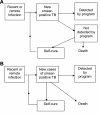New measurable indicator for tuberculosis case detection
- PMID: 15498151
- PMCID: PMC3320308
- DOI: 10.3201/eid1009.040349
New measurable indicator for tuberculosis case detection
Abstract
The World Health Organization's goal for tuberculosis (TB) control is to detect 70% of new, smear-positive TB cases and cure 85% of these cases. The case detection rate is the number of reported cases per 100,000 persons per year divided by the estimated incidence rate per 100,000 per year. TB incidence is uncertain and not measured but estimated; therefore, the case detection rate is uncertain. This article proposes a new indicator to assess case detection: the patient diagnostic rate. The patient diagnostic rate is the rate at which prevalent cases are detected by control programs and can be measured as the number of reported cases per 100,000 persons per year divided by the prevalence per 100,000. Prevalence can be measured directly through national prevalence surveys. Conducting prevalence surveys at 5- to 10-year intervals would allow countries with high rates of disease to determine their case detection performance by using the patient diagnostic rate and determine the effect of control measures.
Figures





References
-
- Millennium Development Goals—A complete listing of the goals, targets, and indicators for MDGs [homepage on the Internet]. Washington: The World Bank Group. [updated 2003] [Sep; cited 2004 Jun 4]. Available from: http://www.developmentgoals.org/Goals.htm
-
- Styblo K, Bumgarner JR. Tuberculosis can be controlled with existing technologies: evidence. The Hague: Tuberculosis Surveillance Research Unit; 1991. p. 60–72.
Publication types
MeSH terms
LinkOut - more resources
Full Text Sources
Medical
